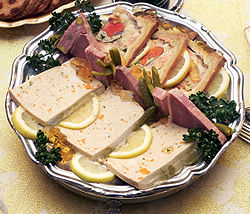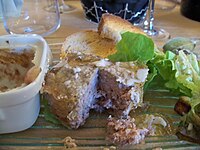|
Pâté
Pâté (UK: /ˈpæteɪ/ PAT-ay, US: /pæˈteɪ, pɑː-/ pa(h)-TAY, French: [pɑte] ⓘ) is a forcemeat. Originally, the dish was cooked in a pastry case; in more recent times it is more usually cooked without pastry in a terrine. Various ingredients are used, which may include meat from pork, poultry, fish or beef; fat; vegetables; herbs; spices; wine; and brandy. History and etymologyBoth the Dictionnaire de l'Académie française and the Oxford English Dictionary (OED) date the term back to the 12th century. The former gives the original meaning as a "culinary preparation consisting of minced meat or fish surrounded by dough and baked in the oven";[1] the OED's definition is "a pie or pastry usually filled with finely minced meat, fish, vegetables, etc."[2] The French words pâte (pastry) and pâté are both derived from the Latin pasta meaning paste or dough (as is the English "pastry").[3] By the 19th century the pastry case was often dispensed with.[2] According to Larousse Gastronomique, when there is a pastry case the dish is pâté en croute and when there is not, and the mixture is cooked in a dish (called a terrine), it is pâté en terrine, often abbreviated to terrine or pâté, terms used interchangeably in both French and English usage.[4] A patty is a similar dish, and its name comes from a 19th-century English corruption of the French word pâté. Pâté was known to the Romans, who generally made it with pork, although other main ingredients might include marinated and spiced birds' tongues.[4] In the Middle Ages, there were numerous recipes for pâtisseries (meats – pork, poultry, game or fish – cooked in pastry).[4] Tinned pâté, being shelf-stable, has sometimes been included in military rations,[5] for, among others, the French Armed Forces, whose rations have included tinned pâté for more than 100 years.[6] VarietiesThere are numerous varieties of French pâtés or terrines, including:
ParfaitChicken liver parfait is a subtype of pâté. Instead of first cooking the livers in butter, for a parfait they are initially pureéd when raw and then passed through a sieve or put in a blender before being mixed with, typically, eggs, fortified wine, shallots, thyme, garlic and cognac and cooked in a bain-marie until set. This allows for a smoother texture.[21] Other countriesIn former Soviet countries, pâté from liver is very popular and it is commonly known as pashtet (Russian: паштет, "pâté"). Liver from other animals (such as cow) can also be used. The liver is first cooked (boiled or fried) and mixed with butter or fat and seasonings such as fresh or fried onions, carrots, spices, and herbs.[22] It can be further cooked (usually baked), but most often used without any other preparation. In Russia, the pâté is served on a plate or in a bowl, and is typically moulded into the shapes of animals, such as hedgehogs.[23] In Ashkenazi Jewish cuisine, a similar recipe is known as chopped liver, with schmaltz used instead of butter and hard-boiled eggs frequently added. Another common type of pâté in Jewish cuisine, also popular in Russia and Ukraine, is vorschmack, or gehakte herring (chopped herring).[24] In Vietnamese cuisine, pâté is commonly used on bánh mì baguette-type sandwiches.[25]
See alsoReferences
Sources
External links
|
|||||||||||||||||||||||||||||||||||||||||||||||||||||||||||||||||





